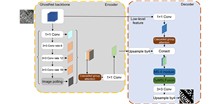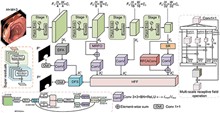
Aiming at the poor segmentation effect caused by the large scale difference of objects, uneven spatial distribution of samples, fuzzy boundary of objects and large span of scene area, this paper proposes a high-precision remote sensing building segmentation algorithm enhanced by integrating dynamic features. Firstly, the New~~GhostNetV2 network is constructed, and the adaptive context-aware convolution is used to improve the algorithm's ability to capture the features of the sample space. Secondly, multi-level information enhancement modules are designed using ghost convolution combined with skip connections and feature branching strategies to enhance the feature integration. Then CGA (cascaded group attention) is introduced to enhance the adaptability of the model to diverse ground object forms through the calculation of independent attention within the group. Finally, the feature fusion module is constructed by the dynamic depth feature enhancer to further enhance the ability of model capture. The experimental results on the WHU data set show that the improved algorithm is 8.57% higher than the baseline model F1-Score and 12.48% higher than mIoU. Compared with other mainstream semantic segmentation models, the improved DeepLabv3+ has better segmentation accuracy.
The Risley grating tracking system is mainly composed of two rotating polarization gratings. The light source is diffracted by the polarization grating to achieve beam pointing in the conical range, and then the target is captured and tracked. As an important index of the Risley grating tracking system, pointing accuracy is not only affected by servo and optical systems but also by system errors such as antenna installation accuracy and shafting assembly error of double grating turntable in the Risley grating tracking system. Therefore, this paper mainly analyzes the systematic error sources in the Risley grating tracking system and the pointing errors caused by them. First, a mathematical model of systematic error is established and verified by ZEMAX. Then, MATLAB is used to analyze the influence of each systematic error source on the pointing error of the Risley grating tracking system. Finally, according to the analysis results and index requirements, the error source of a double grating tracking system is assigned to guide the design and installation of the double grating turntable. The actual maximum pointing error of the double grating turntable δe=7.2" is obtained after several experimental tests, which satisfies the design index of pointing error of the double grating turntable 10".
To reduce the impact of random errors on hand-eye calibration in the visual system of a blade repair robot, an optimization method based on outlier detection is proposed. Firstly, a linear equation for the hand-eye matrix is established. The initial hand-eye matrix is solved using singular value decomposition (SVD). Secondly, the initial value is used to perform an inversion operation on the samples. Outlier samples are detected and removed based on Z-scores, leading to a more accurate hand-eye matrix. Finally, the obtained hand-eye matrix is used as the initial value for optimization. The rotation is represented by unit quaternions, and the Levenberg-Marquardt algorithm is applied to further optimize the initial value, yielding the final hand-eye matrix. Hand-eye calibration experiments were conducted on the blade repair robot equipped with a stereo depth camera. The real coordinates of the target points were obtained using a TCP calibration tool. The predicted coordinates from the hand-eye matrix, obtained by the proposed method, have an average Euclidean distance of 0.858 mm from the true coordinates, with a variance stabilizing below 0.1. Compared to other methods, the proposed approach effectively reduces the impact of random errors and demonstrates good stability and accuracy.
The low detection rate of tiny defects on the surface of metal pipe fittings is a key issue confronting industrial component inspection. In aiming at this problem, an improved YOLOv9-MM model was constructed to improve the accuracy of small target detection. A real-time image acquisition system for precision metal pipe fittings was designed. By using an annular light source combined with a telecentric lens, the surface of pipe fittings can be snapped by the CCD camera and covered at all angles to eliminate the problem of missing areas. The feature map extracted methods of shallow network were introduced, and the upper sampling module of Dysample was combined to realize the dynamic fusion of depth features. By improving the loss function, the precision of small target detection is greatly improved. The results show that the proposed method has an average detection accuracy of 70.2% and a detection speed of 90 f/s. The proposed method shows some feasibility in the actual application.
To address challenges such as regional mis-segmentation and insufficient target localization accuracy in colorectal polyp segmentation, this paper proposes a colorectal polyp segmentation algorithm that integrates adaptive feature selection based on a Transformer. Firstly, the Transformer encoder is employed to extract multi-level feature representations, capturing multi-scale information from fine-grained to high-level semantics. Secondly, a dual-focus attention module is designed to enhance feature representation and recognition capabilities by integrating multi-scale information, spatial attention, and local detail features, significantly improving the localization accuracy of lesion areas. Thirdly, a hierarchical feature fusion module is introduced, which adopts a hierarchical aggregation strategy to strengthen the fusion of local and global features, enhancing the capture of complex regional features and effectively reducing mis-segmentation. Finally, a dynamic feature selection module is incorporated with adaptive selection and weighting mechanisms to optimize multi-resolution feature representation, eliminate redundant information, and focus on key areas. Experiments conducted on the Kvasir, CVC-ClinicDB, CVC-ColonDB, and ETIS datasets achieved Dice coefficients of 0.926, 0.941, 0.814, and 0.797, respectively. The experimental results demonstrate that the proposed algorithm exhibits superior performance and application value in the task of colorectal polyp segmentation.
The accurate identification of the hip joint keypoint is vital for diagnosing developmental dysplasia of the hip. However, in pediatric hip X-ray images, bone regions around key points often exhibit low contrast and blurred edges, resulting in unclear edge features. Furthermore, down-sampling operations during feature extraction further weaken edge information. Key structures surrounding the keypoint are highly susceptible to background interference. Such factors hinder the precise localization of key points. An edge feature and detail-aware integrated YOLOv8s algorithm was proposed for hip joint key point detection. The algorithm designs an edge feature enhancement module to capture spatial information around key points and strengthen edge features. A detail-aware network was designed to integrate and refine multi-level features, enhancing image perception of fine structures. Experiments used a hip X-ray dataset from the Department of Radiology, Children's Hospital of Chongqing Medical University. Results showed reductions in average keypoint localization and angular errors to 4.2090 pixel and 1.4872°, respectively. These reductions, which are 6.8% and 9.9% compared to those of YOLOv8s, highlight significant improvements in detection accuracy. The algorithm enhances keypoint detection precision and provides valuable support for clinical diagnosis.
In response to the on-orbit reconfiguration challenges faced by future large aperture segmented optical systems, a lightweight design method with a wide range of curvature adjustability is proposed. This study initially analyzes the relationship between the characteristics of piezoelectric ceramics and the constitutive equations of thermal strain, deducing that piezoelectric strain can be precisely equivalent to thermal strain. Based on the flexural curve equation, the deformation of piezoelectric ceramics is calculated, enabling the parameterized modeling of an ultra-low expansion (ULE) glass segmented mirror with an edge distance of 510 mm and a curvature radius of 9000 mm. Simulation results indicate that 54 interlaced actuators can achieve a curvature radius reconfiguration of 240.07 mm with a control voltage range of ±20 V, exhibiting a highly linear relationship. Experimental results further demonstrate that when the control voltage is varied between -25 V and 20 V, the change in the curvature radius of the segmented mirror reaches 233.44 mm, with the positive unit voltage corresponding to a greater change in curvature radius than the negative. The proposed method for a wide range of curvature adjustable segmented mirrors provides new insights for the engineering application of large aperture segmented optics in on-orbit reconfiguration.
In response to the problems of traditional defect detection algorithms, such as poor accuracy and feature loss in practical applications due to the inconspicuous characteristics of welding defects and complex background information, this paper proposes a welding surface defect detection algorithm based on the improved YOLOv8 (GD-YOLO). The model first introduces the fusion of feature extraction modules and convolutional modules to enhance its information extraction capabilities. Then, a slim-neck structure is embedded in the neck network, and the upsampling operator CAFARE is referenced in the feature fusion stage to assist in enhancing the model's performance. Subsequently, the attention mechanism module is improved to optimize the overall performance without significantly increasing the computational burden. Finally, the loss function is changed to Inner-SIOU to address the problem of mismatched bounding boxes. Experimental results show that the mAP0.5 detection metric of the model in this paper is 7.8% higher than that of the baseline model, and the number of parameters and the amount of computation are reduced by 0.2 M and 0.7 G, respectively.
Increasing the active vibration isolation capability between the optical payload and the motion platform has always been a challenge for optoelectronic tracking systems. Therefore, a dual observer method is proposed to achieve wide-band disturbance rejection for an inertially stabilized platform. The dual observer method consists of two aspects. Firstly, a classical error observer has a strong low-frequency suppression ability through the design of a low-pass filter. Secondly, a saturated acceleration disturbance observer improves its disturbance suppression characteristics and completes the rejection of medium and high-frequency disturbances by adjusting the saturation threshold and filter bandwidth according to its stability conditions. The dual observer combines both advantages, and the interaction between the two observers is analyzed for better parameterization. Closed-loop verification of the proposal is carried out using the inertial stabilization device. The experimental results show that the dual observer can improve the closed-loop performance under both single-frequency and mixed-frequency disturbances.
To address the poor visibility of submerged bleeding points during endoscopic surgery, which can extend hemostasis procedures, a method combining 4-LED illumination with a saturation-to-hue mapping algorithm is proposed for enhancing bleeding points visibility. With imaging specificity for tissue and blood of varying concentrations, four narrow-band LEDs synchronous lighting are used for imaging, replacing the conventional xenon light source. In the xyY color space, the saturation information of the image is stretched and then mapped to the hue, effectively increasing the color differences between submerged bleeding points and the surrounding areas. Vitro experimental results using rigid endoscopes on animal materials demonstrate that the enhanced images achieved significantly higher color difference between bleeding points and their surroundings than conventional white-light images (41.31>11.78). Saturation-to-hue mapping imaging (SHMI) effectively improves the visibility of submerged bleeding points and reduces the risk associated with endoscopic surgeries.














